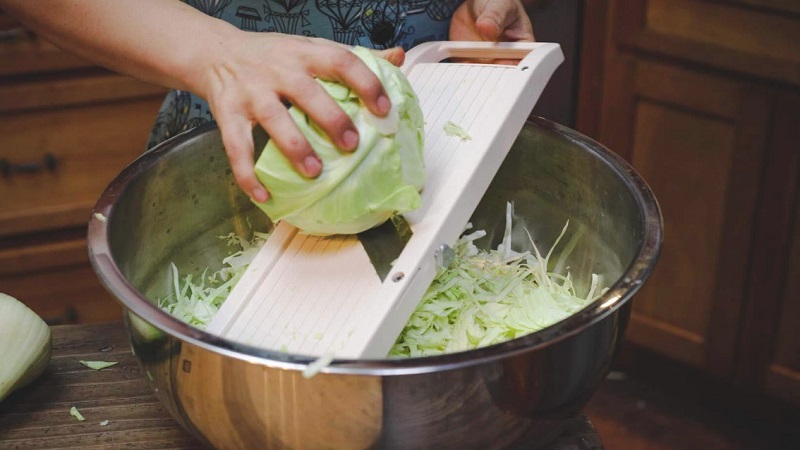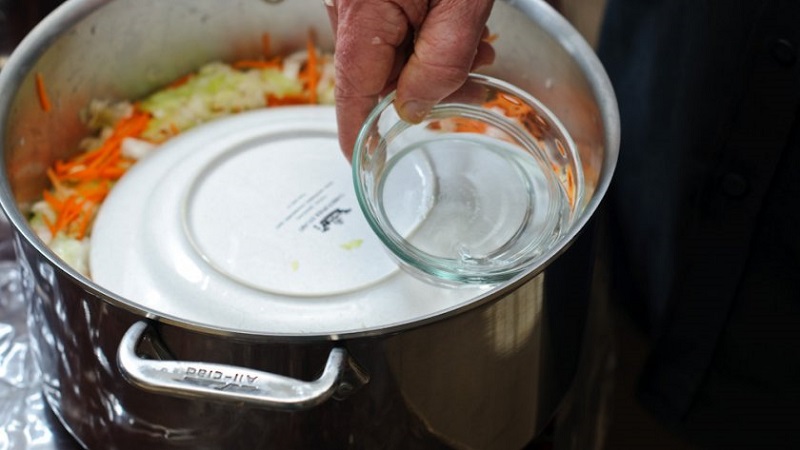Is it possible to salt and ferment cabbage in a stainless saucepan
When planning to make preparations for the winter, housewives often ask themselves the question: from what material can you choose containers for cabbage sourdough? It all depends on the volumes. You can take glass jars, plastic and wooden barrels, nickel-plated dishes. Is it possible to ferment cabbage in a stainless steel saucepan or tank?
The content of the article
Can cabbage be salted in a stainless saucepan
Stainless steel cookware is very popular because microorganisms do not multiply on its surface, and this is the most important factor in cooking... Also, the material is resistant to various acids and corrosion.

The sourdough process of cabbage consists precisely in the release of acids and bacteria.... If this happens in a stainless steel container, the acid will not react with the container material. This means that the technology and taste will not change. The stainless steel container is suitable for quick fermentation of the product so that it can be consumed earlier. In this case, the shelf life of the dish is reduced.
Important! A stainless steel tank or saucepan should not contain nickel, otherwise you cannot ferment cabbage in it.
How suitable are stainless steel dishes for salting
As already mentioned, the surface of the stainless steel container prevents microbes from multiplying and does not oxidize. For this reason, many housewives use such utensils for fermenting vegetables.
But it is worth remembering that this process forms acids that are capable of interacting with various materials. therefore stainless steel containers should be chosen without additional impurities and must be used for food... Also, the manufacturer must indicate the suitability of the utensils for long-term food storage.
Important! Stainless steel dishes are mainly used directly for cooking. And cabbage is not fermented in one day and is not eaten right away either. Therefore, such a container is suitable for starter culture, but not for storage.
At the end of the fermentation process, the finished product should be transferred to glass jars or enameled containers.
Metal utensils in general for pickling cabbage
The cookware selected should have a wide top to accommodate the load. If the container is made of low-quality material, the workpiece may lose its taste, and the shelf life may decrease. therefore it is worthwhile to approach the choice with all responsibility:
- Enamelware great for pickling. The main selection criterion is integrity. If there is a chip on the pan, you should not use it, because the interaction of acid with metal can form an unpleasant odor and a gray tint, and the salting can deteriorate. Whole dishes can not only withstand the entire salting process, but also become a storage container in the future.
- Stainless steel cookware Is not the best choice for storing sauerkraut. The thing is that during the fermentation acid is released, which interacts with various materials, which can shorten the shelf life and change the taste of pickles. It is best to use containers only for the sourdough process, but store the finished product in a glass or ceramic container.
- To metal dishes also applies aluminum, in which it is absolutely impossible to ferment cabbage. It is forbidden to store even cooked food in such dishes.Aluminum quickly reacts with acids found in foods, including cabbage. After such a reaction, the snack will be dangerous to human health, because it can cause poisoning.

It is not difficult to choose a container for sauerkraut, but it is better not to risk it and do not use metal containers not intended for food.
Take a note:
The best sauerkraut recipe in a stainless tank
When harvesting for the winter, everyone uses white cabbage, which contains many useful substances and vitamins. The recipe for sauerkraut with spices in a stainless steel tank will compete with the classics.
For cooking you need the following ingredients:
- cabbage - 10 heads of cabbage;
- carrots - 400-500 g;
- apples - 0.5 kg;
- caraway seeds - 10 g;
- black peppercorns - 50 g;
- bay leaf (optional);
- salt - 200-300 g;
- anise - 10 g.
Cooking method:
- Wash carrots, peel and set in small slices.
- Remove the top leaves from the cabbage and chop into small strips.
- In a separate container, mix the cabbage and salt thoroughly and crush to form juice.
- We pre-wash the container, disinfect it, scald it and dry it completely. The container must be absolutely dry, otherwise the shelf life of the product will decrease or the snack will generally deteriorate.
- Put the vegetable leaves in an even layer on the bottom of the tank. To make the cabbage ferment faster, you can add a crust of rye bread.
- Next, tamp the cabbage mixture onto the sheets.
- Lay the carrots on top in an even layer.
- Then apples, cut into equal slices.
- Repeat layers until we run out of ingredients.
- Between the layers, a hoard of cumin and anise tied in gauze.
- Cover the last layer with gauze and place the load.
- When foam appears, pierce the cabbage to release the gas.
- The dish will be ready in a week at a temperature of + 18 ° C. If the room is warmer, the cabbage will ferment faster.
- We send the fermented vegetables to a cool storage place, after removing the cargo. It is important that the brine completely covers the cabbage.

Such sauerkraut has pleasant spicy taste, smell and crunch.
Attention! If mold appears on top, it must be carefully collected, the load must be rinsed, and the gauze must be washed and boiled.
Conclusion
You can ferment cabbage in stainless steel. To make the workpiece tasty and stored for a long time, you need to carefully process the dishes before salting, use a proven recipe and observe the temperature regime.